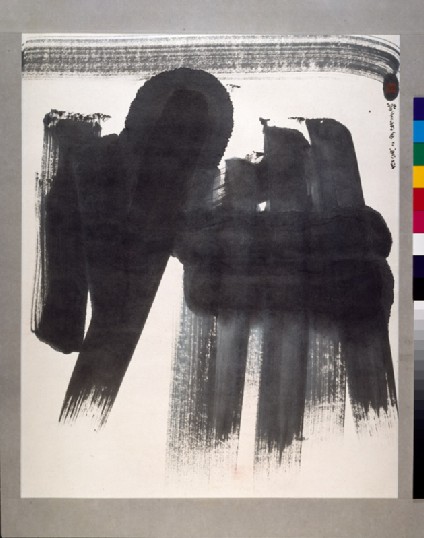Chinese Paintings in the Ashmolean Museum, Oxford
A catalogue of the Ashmolean collection of Chinese paintings by Shelagh Vainker (published Oxford, 2000).

Publications online: 222 objects
- Reference URL
Actions
Reflection
-
Literature notes
Lui Shou-kwan was from Heshan in Guangdong province. He graduated in economics at Guangzhou University and settled in Hong Kong in 1948. The following year he joined the Hong Kong and Yaumati Ferry Company as an inspector, working there until 1966, but he always continued to paint. He was an energetic teacher of ink painting both at the University of Hong Kong, Department of Architecture, and in the Extramural Studies Department of the Chinese University of Hong Kong. From 1954 until his death he was active in numerous Hong Kong art societies. His work falls broadly into two categories: Hong Kong landscapes, and Chan (Zen) paintings. Lui is noted for his use of abstraction, inspired at least as much by early Chinese precedents as by American painting, and for introducing Western styles of painting in Hong Kong. Lui exhibited frequently in Hong Kong and the U.K., with exhibitions in 1963, 1967 and 1974 at the Ashmolean Museum. A further Ashmolean exhibition was held in 1982. -
Details
- Associated place
- Date
- 1962
- Artist/maker
-
Lui Shou-Kwan (1919 - 1975) (artist)
- Material and technique
- ink and colour on paper
- Dimensions
- 48.26 x 38.1 cm (height x width)
- Material index
- Technique index
- Object type index
- No. of items
- 1
- Credit line
- Presented by Lui Shou-kwan, 1962.
- Accession no.
- EA1962.246
-
Further reading
Vainker, Shelagh, Chinese Paintings in the Ashmolean Museum, Oxford (Oxford: Ashmolean Museum, 2000), no. 86 on p. 107, p. 24, illus. p. 107 fig. 86
Location
-
- currently in research collection
Objects are sometimes moved to a different location. Our object location data is usually updated on a monthly basis. Contact the Jameel Study Centre if you are planning to visit the museum to see a particular object on display, or would like to arrange an appointment to see an object in our reserve collections.
Publications online
-

Chinese Paintings in the Ashmolean Museum, Oxford
Lui Shou-kwan was from Heshan in Guangdong province. He graduated in economics at Guangzhou University and settled in Hong Kong in 1948. The following year he joined the Hong Kong and Yaumati Ferry Company as an inspector, working there until 1966, but he always continued to paint. He was an energetic teacher of ink painting both at the University of Hong Kong, Department of Architecture, and in the Extramural Studies Department of the Chinese University of Hong Kong. From 1954 until his death he was active in numerous Hong Kong art societies. His work falls broadly into two categories: Hong Kong landscapes, and Chan (Zen) paintings. Lui is noted for his use of abstraction, inspired at least as much by early Chinese precedents as by American painting, and for introducing Western styles of painting in Hong Kong. Lui exhibited frequently in Hong Kong and the U.K., with exhibitions in 1963, 1967 and 1974 at the Ashmolean Museum. A further Ashmolean exhibition was held in 1982.
Notice
Object information may not accurately reflect the actual contents of the original publication, since our online objects contain current information held in our collections database. Click on 'buy this publication' to purchase printed versions of our online publications, where available, or contact the Jameel Study Centre to arrange access to books on our collections that are now out of print.
© 2013 University of Oxford - Ashmolean Museum

